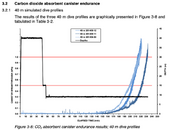Mike, those headaches hurt don't they!
You don't clarify if you're diving with a JJ-DSV, or BOV. If BOV whose?
Why is this important... If you've substituted the JJ-DSV for a Shrimp BOV for example then you've probably increased your loop WOB and likely decreased the scrubber endurance from that tested. And if you bailed off onto it your condition might not have improved much due to known high WOB irrespective of gas density!
What granular absorbent were you diving: manufacturer, type and date.
Different absorbents give VERY different results...
Were you diving something that gives less of a duration than that tested?
Rebreathers variation in performance at depth might or might not differ; see
Ireland | John Clarke Online
You've already self-identified that you've overbreathed the scrubber, exceeded its safe diving envelope and had a breakthrough due to your high workload on a working dive with 100min on the scrubber at depth...
A commercial working dive with heavy camera equipment, where current and jobsite time pressures are a risk, gives a very different pre-dive planning risk assessment than a fun recreational dive.
I note you mention that the JJ-CCR has a 180min duration... But does it for your specific circumstance?
Noting that 180min is based off 3 odd scrubber tests at 40m on VERY importantly for your circumstance a PROFILE dive. And not a constant 40m BT!
The measurement (in this case) is also taken from upstream of the DSV and not from the divers mouth; so you have to take into account the DSV/BOV deadspace in your figuring and the reduction this causes.
Looking at that profile scrubber duration it was tested for only 40min at 40m, then 5min at 15m and remaining time at 9m.....
Your dive I understand was 80min mostly at 25m with a little deco and then 20min again at 25m.
So you spent 40min at 15m less than the published scrubber duration testing by JJ @QinetiQ but also roughly a further 50min odd
working at 16m greater than the 180min dive profile JJ tested for.....
Controversial but based off the test data available to you and the details you've given, it looks like you can only
plan on a
known safe 40min BT at 25m (80ft) off each fresh scrubber fill, where a period of
high workload is a consideration...
Diving at 10'C gives a benefit but how much over 4'C on your unit is pure guess work and it might not be that much of a buffer on your safety!




